Related Research Articles
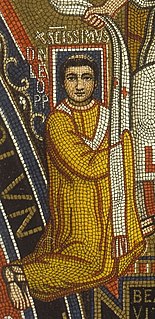
Pope Leo III was bishop of Rome and ruler of the Papal States from 26 December 795 to his death. Protected by Charlemagne from the supporters of his predecessor, Adrian I, Leo subsequently strengthened Charlemagne's position by crowning him emperor. The coronation was not approved by most people in Constantinople, although the Byzantines, occupied with their own defenses, were in no position to offer much opposition to it.
Pope Marinus I was the bishop of Rome and ruler of the Papal States from 882 until his death. Controversially at the time, he was already a bishop when he became pope, and had served as papal legate to Constantinople. He was also erroneously called Martin II leading to the second pope named Martin to take the name Martin IV.
Pope Benedict VI was the bishop of Rome and ruler of the Papal States from 19 January 973 to his death in 974. His brief pontificate occurred in the political context of the establishment of the Holy Roman Empire, during the transition between the reigns of Otto I and Otto II, incorporating the struggle for power of Roman aristocratic families such as the Crescentii and Tusculani.
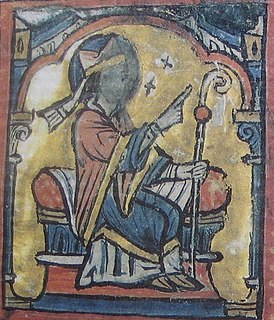
Pope Clement III, was the head of the Catholic Church and ruler of the Papal States from 19 December 1187 to his death. He ended the conflict between the Papacy and the city of Rome, by allowing the election of magistrates, which reinstalled the Papacy back in the city after a six year exile. Clement, faced with a deplete college of cardinals, created thirty-one cardinals over three years, the most since Hadrian IV. He died 20 March 1191 and was quickly replaced by Celestine III.
Pope Stephen IX was the head of the Catholic Church and ruler of the Papal States from 3 August 1057 to his death. He was a member of the Ardenne-Verdun family, who ruled the Duchy of Lorraine, and started his ecclesiastical career as a canon in Liège. He was invited to Rome by Pope Leo IX, who made him chancellor in 1051 and one of three legates to Constantinople in 1054. The failure of their negotiations with Patriarch Michael I Cerularius of Constantinople and Archbishop Leo of Ohrid led to the permanent East-West Schism. He continued as chancellor to the next pope, Victor II, and was elected abbot of the Benedictine monastery of Montecassino.
Pope Sergius III was the bishop of Rome and nominal ruler of the Papal States from 29 January 904 to his death. He was pope during a period of violence and disorder in central Italy, when warring aristocratic factions sought to use the material and military resources of the papacy. At the behest of Theophylact I of Tusculum, Sergius seized the papal throne from Antipope Christopher, who in turn had deposed Pope Leo V. Sergius' reign was subsequently marked by Theophylact's influence. As pope, Sergius continued many ecclesiastical controversies of his predecessors, including conflict over Pope Formosus' legacy, annulling all ordinations made by the late pope, and the filioque controversy with eastern patriarchs. His pontificate was similarly marked by temporal conflicts, with Sergius' refusal to crown Berengar I of Italy as Holy Roman Emperor, and his support of Byzantine Emperor Leo VI the Wise's fourth marriage. Sergius also saw the restoration of the Lateran Palace.
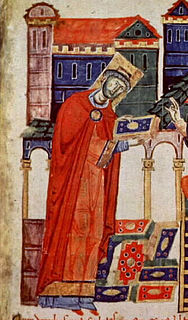
Pope Victor III, was the head of the Catholic Church and ruler of the Papal States from 24 May 1086 to his death. He was the successor of Pope Gregory VII, yet his pontificate is far less notable than his time as Desiderius, the great abbot of Montecassino.
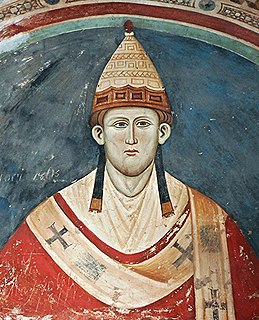
Pope Innocent III, born Lotario dei Conti di Segni, was the head of the Catholic Church and ruler of the Papal States from 8 January 1198 to his death in 16 July 1216.
Pope Formosus was the bishop of Rome and ruler of the Papal States from 6 October 891 until his death on 4 April 896. His reign as pope was troubled, marked by interventions in power struggles over the Patriarchate of Constantinople, the Kingdom of West Francia, and the Holy Roman Empire. Because he sided with Arnulf of Carinthia against Lambert of Spoleto, Formosus's remains were exhumed and put on trial in the Cadaver Synod. Several of his immediate successors were primarily preoccupied by the controversial legacy of his pontificate.
Pope Leo VIII was a Roman prelate who claimed the Holy See from 963 until 964 in opposition to John XII and Benedict V and again from 23 June 964 to his death. Today he is considered by the Catholic Church to have been an antipope during the first period and the legitimate pope during the second. An appointee of Holy Roman Emperor Otto I, Leo VIII's pontificate occurred after the period known as the Saeculum obscurum.
Pope Nicholas I, called Nicholas the Great, was the bishop of Rome and ruler of the Papal States from 24 April 858 until his death. He is remembered as a consolidator of papal authority, exerting decisive influence on the historical development of the papacy and its position among the Christian nations of Western Europe. Nicholas I asserted that the pope should have suzerainty over all Christians, even royalty, in matters of faith and morals.
Pope John XIII was the bishop of Rome and ruler of the Papal States from 1 October 965 to his death. His pontificate was caught up in the continuing conflict between the Holy Roman emperor, Otto I, and the Roman nobility. After long and arduous negotiations, he succeeded in arranging a Byzantine marriage for Otto II, in an effort to legitimize the Ottonian claim to imperial dignity. He also established church hierarchy in Poland and Bohemia.
Pope John XIX, born Romanus, was the bishop of Rome and ruler of the Papal States from 1024 to his death. He belonged to the family of the powerful counts of Tusculum, succeeding his brother, Benedict VIII. Papal relations with the Patriarchate of Constantinople soured during John XIX's pontificate. He was a supporter of Emperor Conrad II and patron of the musician Guido of Arezzo.
Pope John VIII was the bishop of Rome and ruler of the Papal States from 14 December 872 to his death. He is often considered one of the ablest popes of the 9th century.
Anastasius Bibliothecarius or Anastasius the Librarian was bibliothecarius and chief archivist of the Church of Rome and also briefly a claimant to the papacy.

The Photian Schism was a four-year (863–867) schism between the episcopal sees of Rome and Constantinople. The issue centred on the right of the Byzantine Emperor to depose and appoint a patriarch without approval from the papacy.
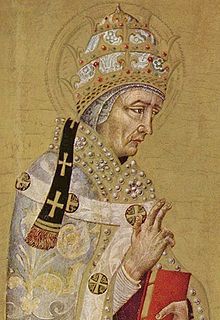
The selection of the pope, the bishop of Rome and supreme pontiff of the Roman Catholic Church, prior to the promulgation of In nomine Domini in 1059 varied throughout history. Popes were often appointed by their predecessors or by political rulers. While some kind of election often characterized the procedure, an election that included meaningful participation of the laity was rare, especially as the popes' claims to temporal power solidified into the Papal States. The practice of papal appointment during this period would later result in the jus exclusivae, i.e., a right to veto the selection that Catholic monarchs exercised into the twentieth century.

In 9th-century Christianity, Charlemagne was crowned as Holy Roman Emperor, which continued the Photian schism.
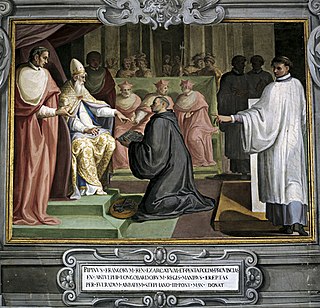
From 756 to 857, the papacy shifted from the orbit of the Byzantine Empire to that of the kings of the Franks. Pepin the Short, Charlemagne, and Louis the Pious had considerable influence in the selection and administration of popes. The "Donation of Pepin" (756) ratified a new period of papal rule in central Italy, which became known as the Papal States.
References
- 1 2 Herbermann, Charles, ed. (1913). . Catholic Encyclopedia . New York: Robert Appleton Company.
- ↑ Seven Apostles of Bulgaria, Oxford Dictionary of Saints, Ed. David Farmer, (Oxford University Press, 2004), 474.
- ↑ Richard P. McBrien, Lives of the Popes, (HarperCollins, 2000), 144.
- ↑ Richard P. McBrien, Lives of the Popes, 143.
- ↑ Roger Collins (1 Jan 2009). Keepers of the Keys of Heaven: A History of the Papacy. Basic Books. p. 170. ISBN 9780786744183.
- ↑ Francis Dvornik. The Photian schism: history and legend. CUP Archive. p. 229.
- ↑ Greville Stewart Parker Freeman-Grenville; Stuart Christopher Munro-Hay (26 January 2006). Islam: An Illustrated History. Bloomsbury Publishing USA. p. 46. ISBN 9781441165336.
- ↑ David Thomas; Barbara Roggema; Juan Pedro Monferrer Sala (21 March 2011). Christian-Muslim Relations. A Bibliographical History. Volume 3 (1050-1200). BRILL. p. 48. ISBN 9789004195158.